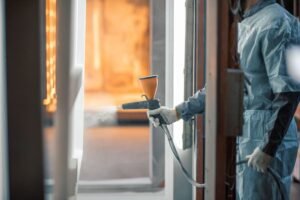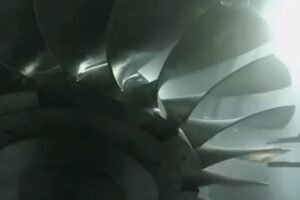Vaccum Casting Service
From initial concept to final delivery, our comprehensive services cover every step of the product development process.

Vaccum Casting
Vacuum casting, also known as urethane casting, is a versatile and cost-effective method for producing high-quality plastic parts in low to medium volumes. At Seamark Prototype, we offer advanced vacuum casting services that bridge the gap between 3D printing and injection molding, providing an excellent solution for prototyping and small-scale production.
Our Vaccum Casting Processes
Master Pattern Creation:
• Usually 3D printed with high precision (SLA or MJF)
• Can also be CNC machined for certain applications
Silicone Mold Making:
• High-quality silicone rubber is used for mold creation
• Molds capture intricate details and provide excellent surface finish
Vacuum Casting:
• Two-part polyurethane resin is mixed and poured into the mold
• Vacuum environment ensures removal of air bubbles, resulting in dense, void-free parts
Curing and Post-Processing:
• Parts are cured in temperature-controlled ovens
• Post-processing includes de-gating, finishing, and painting if required
Materials We Work With
Urethane Resins offers excellent clarity, flexibility, and impact resistance. Cast urethane parts can simulate injection molded plastics. Ideal for functional prototypes and end-use parts at low volumes.
We provide complete ABS machining service and can produce custom ABS parts in various shapes and grades.
Epoxy Resins known for high stiffness, dimensional stability, and good temperature resistance. Epoxies replicate technical thermoplastics like ABS, polycarbonate, nylon. Great for precise functional testing.
Match the look, feel and properties of production ABS plastic. Well-suited to models requiring realistic plastic aesthetics, snap-fits, hi-fidelity, and more.
Cast acrylic parts provide optical clarity, UV/weather resistance and mimic products eventually made from injection molded acrylic. Useful for lenses, lighting, and other clear components.
Allow flexible, stretchable parts with high tear strength and thermal stability. Used to simulate rubber, flexible seals, keypads and other elastomers in products.
Surface Finishing Options
At Seamark Prototype, we understand that the perfect finish can make all the difference in your product’s performance, durability, and market appeal. Our comprehensive finishing services go beyond mere aesthetics, offering functional enhancements that can significantly improve your parts’ properties. From sleek, polished surfaces to robust, corrosion-resistant coatings, we provide a diverse array of finishing options tailored to your specific needs.
Anodizing: This electrochemical process creates a protective oxide layer on the surface of aluminum parts, providing corrosion resistance and a range of color options.
Powder coating is a type of coating that is applied as a free-flowing, dry powder. Unlike traditional liquid paint, which is applied with an evaporating solvent, powder coating is typically applied electrostatically and cured with heat or ultraviolet light.

Bead blasting produces a smooth, matte-textured surface, and sharp edges can be broken and deburred for safe handling. Bead blasting can also improve the mechanical strength, wear resistance and corrosion resistance of parts.
Electroplating is the process of coating an object in a layer of metal using electrodeposition. Electroplating is widely used to improve the surface qualities of metals, such as resistance to abrasion and corrosion, lubricity, reflectivity, and electrical conductivity. Electroplating can also make metals look better.
Polishing is a technique for creating a smooth and shiny surface by rubbing it or applying a chemical treatment. The process creates a surface with significant specular reflection, but it can also reduce diffuse reflection in some materials.
Brushing is a surface treatment process in which an abrasive belt is used to draw marks and lines on the surface of products to achieve a decorative texture.
One-stop Manufacturing Solutions
Whether you require a single prototype for design verification or mass manufacturing of final products, we're here to help

Rapid Prototyping
Our rapid prototyping capabilities enable you to validate designs, perform functional testing, and iterate quickly. With fast turnaround times and expert guidance, we help you refine your product concept efficiently, accelerating your development cycle and reducing time-to-market.

Low-volume Production
Our low-volume production services bridge the gap between prototyping and mass manufacturing. Ideal for market testing, product launches, or niche markets, we offer flexible production runs typically ranging from 10 to 10,000 units.

Mass Production
We use injection molding, high-speed CNC machining, and automated assembly lines to produce large quantities of your product. Our expert team optimizes your design for manufacturability, develops robust tooling, and implements stringent quality control measures to ensure consistent output.

Why Us
At Seamark, we pride ourselves on our extensive expertise in the mechanical engineering. Our team of professionals is dedicated to providing the highest quality products and services to our customers.
Expertise
Our team comprises highly skilled engineers, technicians, and craftsmen with years of industry experience. Their deep knowledge spans various manufacturing processes, materials, and industries, allowing us to provide expert guidance throughout your project.
Quality Assurance
We use advanced measurement and testing equipment to verify dimensional accuracy, material properties, and functional performance. Our commitment to quality extends beyond the physical product to encompass our customer service, project management, and delivery processes, ensuring a superior experience from start to finish.
Fast Turnaround
Our ability to quickly iterate on designs and produce functional prototypes can significantly accelerate your product development cycle. With Seamark Prototype, you can bring your products to market faster, gaining a competitive edge in your industry.
Frequently Asked Questions
We support all major CAD file types including STEP, IGES, STL, OBJ etc. Designs should be in solid model format for best results.
For standard plastics like ABS and PLA, we can deliver prototypes within 5-7 business days after receiving your design files. More complex projects may take up to 2 weeks.
Yes, we can add moving parts, electronics integration and finishing touches to make prototypes as functional as possible for testing.
We offer surface finishing, assembly, hardware integration and other treatments to make prototypes look and function like finished products.
We respect your intellectual property. None of your information, images, files or likenesses will be shared with any third party, and it will not be used for any advertising, marketing, or promotional use without your explicit written authorization. If you would like to sign NDA agreement, please contact our team for support.
We follow the ISO/IATF standard and guarantee that we will rework the products or refund them if there are any quality problems. The full-dimensional report, material certification, or first article inspection are provided on request before order placement.







